To tell you the truth, you do not actually need substrate for goldfish but it is highly advisable to use it. Having a good quality substrate provides plenty of surface area where beneficial bacteria can grow. These bacteria help break down the harmful nitrates and ammonia coming from the waste produced by the goldfish.
This means that the substrate helps the filtration system of the tank by providing additional biological filtration. Goldfish produce a lot of solid waste, and the tank filter does not always catch all of them. Some of the wastes fall through the substrate where beneficial bacteria will break them down and keep the water clean.
This article, National Park Aquarium will teach you how to choose the best sand substrate for a goldfish tank. This way, you will not only get the most value for your money but will also keep your fish healthy.
Best Substrate for Goldfish Reviews
1. Carib Sea ACS00110 Crushed Coral
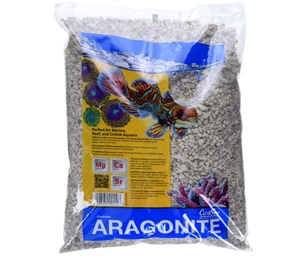
This product for your aquarium is technically not gravel. It entirely consists of coarsely-crushed coral. However, despite being made of coral, it has been treated and desalinated, so it is safe to use even in freshwater tanks. Still, just like a normal aquarium gravel substrate, you should rinse this thoroughly to get rid of dust and dirt.
Crushed coral is somewhat rougher than plain gravel, which means it has a larger surface area in total. It is also an indication that there are plenty more surfaces where beneficial bacteria can grow. The more surface bacteria there are, the better it will be at neutralizing nitrates and ammonia.
Another thing that I liked about this substrate material is that the particles are large enough that I can use them as filter media. I just need to place the substrate material into a filter media bag and then put it inside the filter housing.
It would be like what you would be doing with any other filter media. This substrate works quite well as a biological filter, thanks to the large surface area of every particle.
Another reason why I love using this product is that it also helps balance the pH level of the water. If you are having trouble with the pH balance of your tank, you can add this substrate.
The corals help neutralize the ammonia. They can also lower the acidity of the water. It took my tank less than a week to normalize its pH level and it has not spiked up or down ever since.
Although it did not happen to me, I have read reviews that their batch of crushed coral substrate contained parasites. I try to avoid problems with parasites by boiling new substrate for a couple of minutes to kill any parasites that might be in them. This may seem like a bother for most people, but this one extra step can prevent a lot of problems.
- Made of completely organic corals
- Ideal for both marine and freshwater tanks
- Each piece has a lot of surface area for bacteria to grow on
- Ideal for use as a filter media
- Can help stabilize the pH of the water in the tank
- Some batches might contain parasites
- The pieces are too small if you will be using an under-gravel filter
The issue with the parasites may just be a localized incident but just to be on the safe side, you should wash this gravel in enough boiling water. This will not damage it at all. It will also help provide beneficial bacteria with a great environment where they can thrive.
If you have a goldfish tank, this substrate for fancy goldfish will help keep the ammonia and nitrates level down to healthy levels.
2. Seachem Flourite Natural Substrate
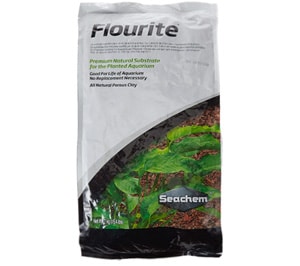
If you are thinking of starting a goldfish tank with live plants, I highly recommend using this substrate. Fluorite is a naturally-occurring mineral, and it is great for planted tanks because it behaves just like loose soil. The particles are small, and would also compact a bit after a while, so the plants’ roots can take hold easily.
Another thing I liked about this product is that it is not chemically treated, so it will not affect the pH level of the tank’s water in any way whatsoever. With that said, this will not help balance the pH level of the aquarium at all. If you already have an established aquarium, adding this substrate will not botch up the water chemistry.
This substrate also works well on its own. It does not need any additional gravel modifiers. If you are starting a new tank, you just need a thick enough layer of this substrate then start planting.
This already contains enough nutrients and minerals to help the plants establish themselves. The addition of waste from the goldfish will only make it better.
I also like the brick red color of this gravel substrate. The earthy color makes it look more natural, especially when you have a couple of plants in your tank. In addition, the brick-red color makes it one amazing option for the most suitable substrate for Oranda goldfish. The color of the fish just contrasts really well with the substrate.
The only issue I had with this product is how dusty the contents are. Even though it already came pre-washed, there is still a considerable amount of dust inside the bag. This is because fluorite is a bit soft, so when the particles rub against each other during transit, it produces a lot of dust.
- Ideal for planted tanks as it can allow plant roots to take hold
- Not chemically coated, so it will not affect the pH balance of the water
- Already comes pre-washed
- Does not need gravel modifiers
- Has a nice brick color
- Even though the substrate is already pre-washed, the substrate can still produce dust
- Can leave the tank extremely cloudy for a day or two even after washing
Even though it was quite stressful when I first used this substrate because it left my aquarium quite murky, it still made my tank look great once the particles have finally settled.
3. Estes Gravel AES06606 Este Marine Sand
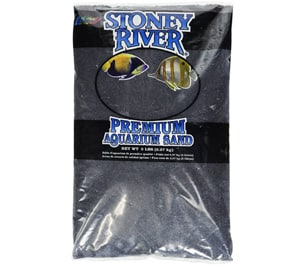
If you want to keep living plants in your goldfish tank, you should seriously consider using this perfect substrate for a planted goldfish tank. This is still a coarse substrate, so it will not make the water permanently murky.
What it does, instead, is it will provide a good anchor point for your aquatic plants. Even young plants will have a good chance of thriving since their roots will take hold almost immediately.
Some goldfish like to swallow rocks and sand to help them grind down the food that they have eaten. This substrate is just the right size for this purpose. Don’t worry about the jagged edges of the gravel injuring your fish because this substrate is relatively soft.
It would smoothen as it passed through the fish’s gut. Also, the particles are not so large that they might choke the goldfish.
Just like any other aquarium substrate, you will still need to rinse this black sand thoroughly before you put it in your tank. However, this is not quite as dusty as other aggregates.
Unlike other gravel products that I have used so far, I only needed to rinse this two times before the water ran clear. However, there were still some sediments that made the water cloudy but it did settle after a couple of hours.
The biggest reason why I liked this substrate is simply that it looks good. I like how the colors of my goldfish have a stark contrast against the black substrate. The dark color effectively hides the goldfish waste that the filter has not picked up yet. This means you can get away with not vacuuming the gravel longer since the dirt is not that visible.
Although this does not have as much dust as other aquarium substrates, the small amount that it has tends to hang in the water for quite a while. The first time I used this substrate, the water was a tad bit cloudy for 2 to 3 days. It was not too bad but it was noticeable, especially with the tank lights turned on.
- This fine substrate provides a good anchor point for living plants
- The particles are small enough that the fish can swallow them to help them digest
- The black sand looks quite nice, especially for a monochromatic design
- Still dusty but easy to clean and prepare for aquarium use
- Does not discolor the water in the tank
- The particles are much too small for an under-gravel filter
- The dust takes a day or two to settle at the bottom
This black substrate sand is the ideal choice for planted goldfish tanks. Aside from making the other colors pop, it also masks the waste deposited by the goldfish. If you want your underwater garden to thrive, this substrate may just be the one that you need.
4. AQUANATURAL Oolitic Aragonite Aquarium Sand
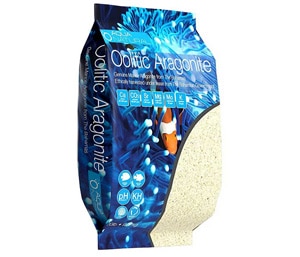
The reason why this substrate is a bit on the pricey side is that it came straight from the beautiful beaches of the Bahamas. The manufacturers source the sand straight from a renewable resource right in the Bahamas, which is why it is so white and fine. It is the best choice if you have a reef tank. The sand makes the whole setup like the real thing.
This is genuine aragonite sand, which is why it is bright white. It is great for reef tanks because the white contrasts well with the bright colors of saltwater fish. I keep a couple of triggerfish and clownfish and their colors stand out when set against the white sand. If you have colorful corals, they will also look nice when placed on this sand.
Another benefit of using aragonite sand is that it will help keep the pH level of your water stable. If you are having trouble keeping the pH level of your aquarium steady, consider using this product.
Ever since I used this sand, the pH level remains at a steady 8.2 reading, and I haven’t had any harmful spikes ever since. Even if your tank is already cycled, adding this substrate to it will not affect the water chemistry.
Another impressive thing I discovered in this product is how consistent the size of the grain is. This sand is so fine that it almost feels like powder. Unlike other beach sand substrates, there are no pebbles or shells that ruin the texture of the sand. It seems like the sand was carefully sifted to remove non-uniform particles from the sand.
There is something that you need to know about this substrate, and that is the fact that it is quite difficult to clean. Because of the very fine consistency of the sand, it will create a lot of dust. You will need to rinse it multiple times before transferring it into your tank.
The water will still be murky even after rinsing the sand. Thankfully, it will clear up in a couple of hours once you turn on the tank filter.
- Contains 100% aragonite sand from the Bahamas
- Keeps the pH level of the water stable
- Consistently fine – There are no large chunks or rocks included in the package
- The color is uniformly white throughout.
- The sand came from a naturally renewable source
- Very difficult to clean initially
- The particles are so small that the water outlet tends to blow them up
Here is the most important thing that you need to know about this product. It is not for goldfish tanks. This is sand that came directly from the Bahamas, which means you only have to use it for saltwater tanks. No amount of rinsing will remove the salt. Now, if you do have a reef or saltwater tank, you will love using this substrate in it.
Factors to Consider When Choosing Substrate for Goldfish
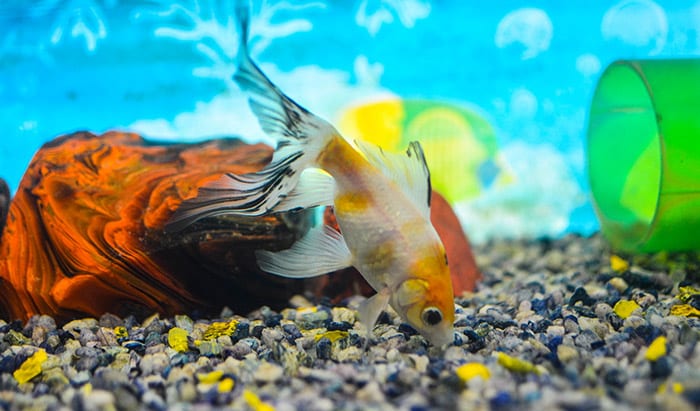
You might think that you do not have to think about what gravel substrate for goldfish you can use in your goldfish tank. However, there are several important things you have to consider to ensure that what you are getting is compatible with your setup. Here are some of them:
1. Sediment Size
For a goldfish tank, you will need to use a substrate that has rather coarse sediment particles. The size of the particles should be larger than coarse sand but smaller than pebbles.
The gravel should be loose enough that the waste from your goldfish can pass through the gaps easily. This will give the beneficial bacteria a chance to break down the waste and the ammonia and nitrates that come from it.
2. Substrate Color
There is no one perfect color of substrate that you need to use in your aquarium. You just need to choose a color that would complement those of your goldfish. Alternatively, you can also choose your favorite color substrate. It is your aquarium, after all, so your choice is all that matters.
3. Presence of Living Plants
Are you keeping living plants in your tank? If you are thinking of keeping live plants in your goldfish tank, you need to use a substrate that can support them.
This means that the substrate should not be too large that the roots of the plants cannot anchor themselves properly. Choose a substrate that is small enough that there are gaps between the particles so plants can take root.
On the other hand, if you will not be keeping live plants, you can choose whatever size of substrate that you feel like using.
4. The Material Used
If you are keeping goldfish, you will then need a substrate that provides a lot of surface area. This means the substrate should have a rough and uneven texture. They actually have more surface area compared to completely smooth particles.
The more surface area sediment has, the more beneficial bacteria can grow on them. I would recommend that you choose crushed coral, lava rocks, and similarly textured substances. These materials will provide you with the most surface area.
5. Ease of Use
Choose a substrate that you can use as soon as possible. The substrate should not contain so much dust that it would take a long time to rinse it thoroughly. If you can, buy a substrate that says that the contents are already pre-washed.
However, the pre-washed substrate can still create a significant amount of dust, so you should still rinse it thoroughly or until the water runs somewhat clear. The water in your tank would still be a bit cloudy but after an hour of letting your filter run, the dust suspended in the water will be removed or settle at the bottom of the tank.
6. Saltwater or Freshwater?
You will not be able to use all substrates interchangeably. There are some, like beach sand, that you can only use for marine or saltwater aquariums.
The reason being is that it is almost impossible to remove the salt from the sand. No matter how many times you rinse it, the sand would still contain a lot of salt.
Source: Luke’s Goldies
Conclusion
Although they do not need it, having the best substrate for goldfish will provide your aquarium with a lot of benefits. For instance, you will love how substrates can stabilize water chemistry.
Also, the substrate provides a place where beneficial bacteria can thrive, and these will be responsible for breaking down the waste produced by the goldfish.




